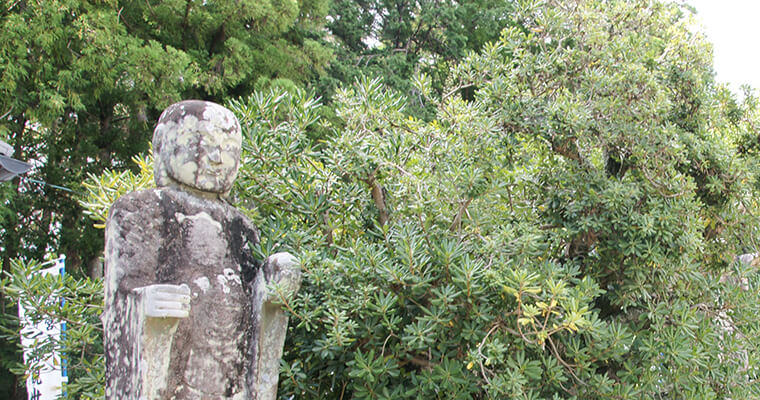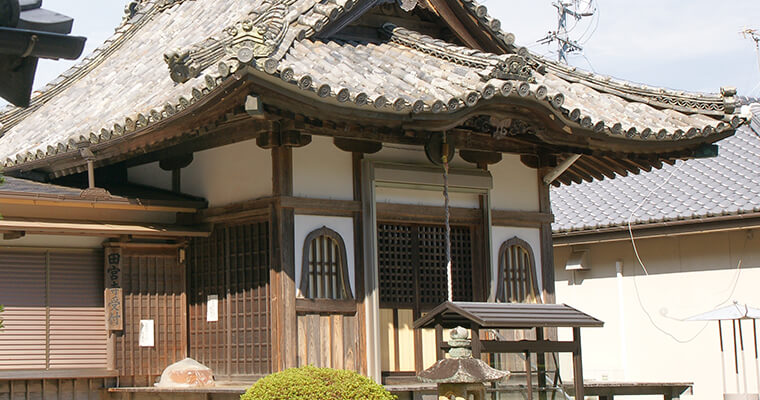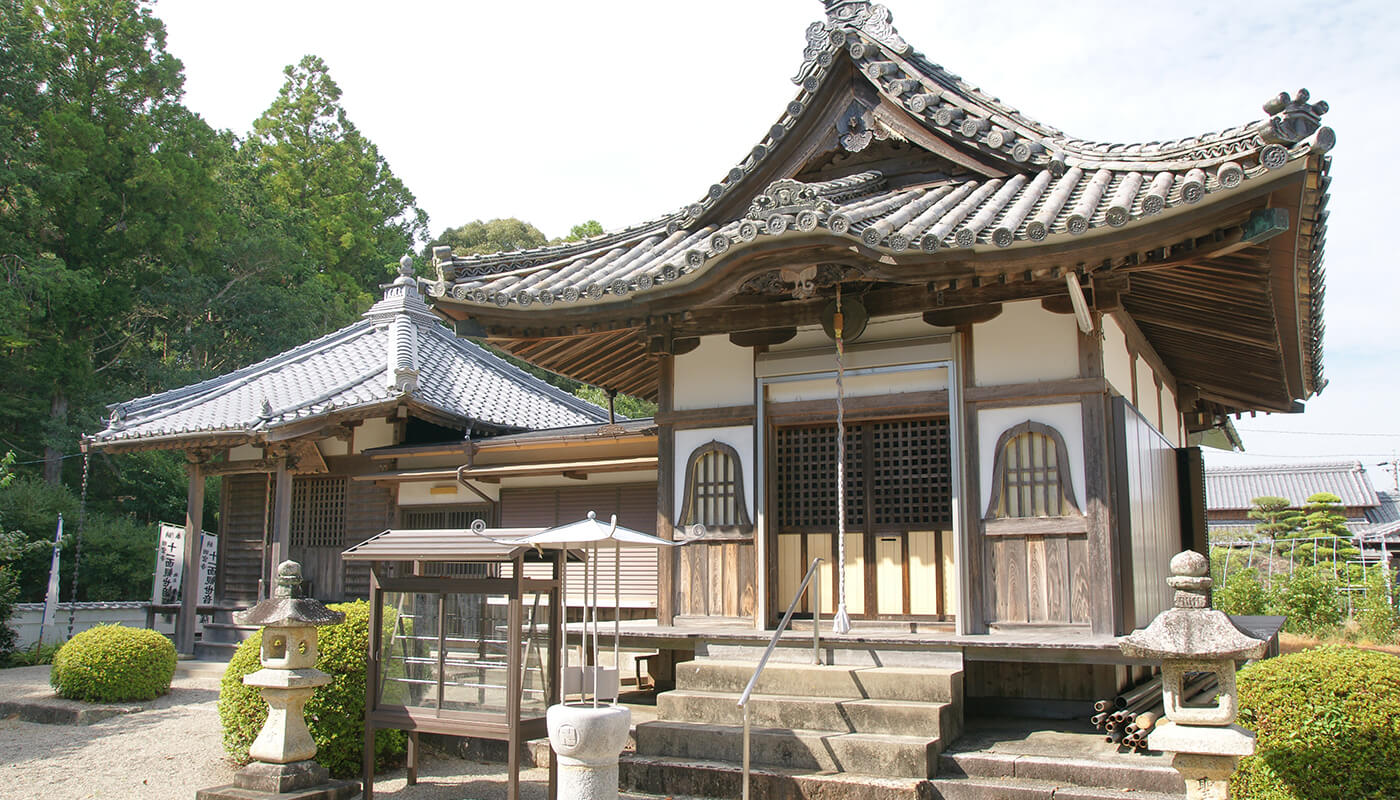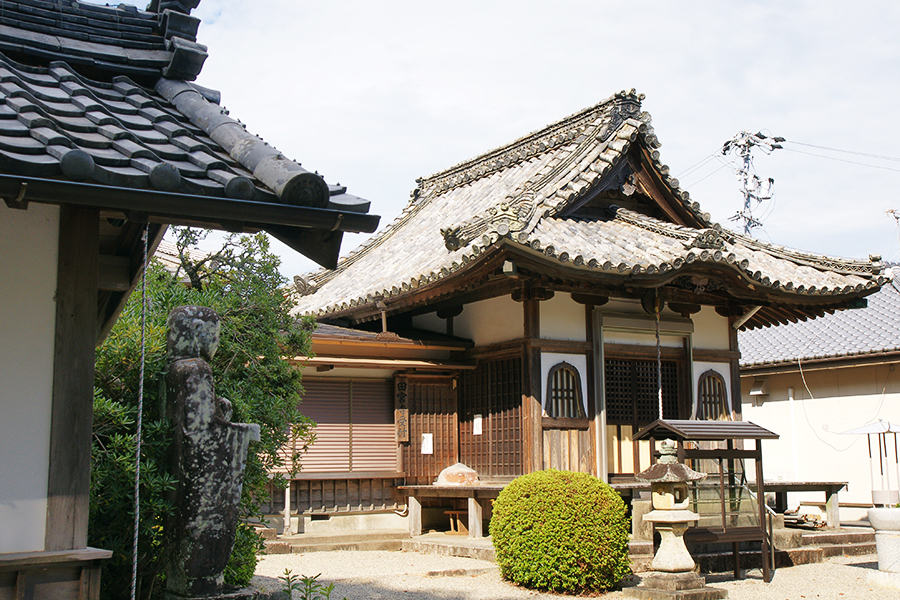Number 4Tamiya-ji temple
History of the temple
Seiyō Gorei Ikyō
Fūkōzan Tamiya-ji Shingon sect, main statue Eleven-faced Kannon, Temple number 8 of Ise Pilgimage
Tamiya-ji temple, where Shinto Gods and Buddhist Gods become one, you don’t pray to each separately because from the beginning they don’t have any form.
According to the records it is a place where Mifune vessel from Ise Shrine is stored.
According to temple’s legend, it was founded by Gyōki (668-749), a famous monk who traveled around Japan to preach to commoners, in September 725. As ordered by Emperor Shōmu (701-756), he named the temple Jingū Hōraku-ji and as a main statue he made two statues of Eleven-faced Kannon. Between 767 and 770 the temple’s buildings were lost in the fire. They were rebuilt thanks to Kūkai (Kōbō Daishi, 774-835, the founder of Shingon sect), who stayed at the grounds for some time after his return from China. Later when Tamiya-ji prospered again, Kūkai was acknowledged and worshiped as a rebuilder of the temple.
According to commentary written by Ōnishi Gen’ichi and included in the official temple’s pamphlet issued by supporter group, Tamiya-ji was built between 995 and 999 by a head of Arakida clan, who was also a head priest at the Ise Shrine. Since then the temple became Arakida’s family temple and abbots were also chosen from members of that clan (and Shingon sect monks at the same time). Because the records from 1496 state that the temple was rebuilt once again that year, it probably fall into a decline at some point.
In Nara (710-794) and Heian (794-1192) period, when Buddhism prospered in Japan, Buddhist temples (Jingū-ji) were built within main Shinto shrine’s grounds. For example a Jingū-ji temple connected to Ise Shrine was placed in Ōkase in Taki-chō district. Tamiya-ji was also constructed as a Hōraku-ji temple – a temple bringing Buddhist teachings and Enlightenment to Shinto gods of Ise Shrine. At its grounds there was a hall called Mifune Hall which would store a box called Mifuneshiro (vessel to transport the divine artefact, originally in a shape of a boat) used during the Shikinen Sengū ritual (rebuilding of the shrine) at the Ise Shrine. The new Mifuneshiro would be presented to Tamiya-ji each twenty years, after it has been used for the ceremony.
Regional powerful clans of Kitabatake, Tamaru and Aisu donated lands of Tamiya-ji village, Katsuta, Yano and Hara village to the temple. According to the land survey conducted in 16th Century, among the temple’s land an equivalent of 5.95 ha (14.7 ac) was the donated land. During 17th and 18th Century this land produced 2t of rice every year.
Beside the Main Hall, more buildings such as Daishi Hall (Hall of Kūkai), Tenjin shrine (Shinto God of Knowledge and Thunders = Sugawara no Michizane), Mifune Hall (Hall with the divine vessel), Shōten Hall (Kangiten, Ganesha, a god of conjugal harmony and long life), Fudō Hall (Hall of Fudō Myō-ō – Immovable Wisdom King), Dainichi Hall (Great Illuminating Buddha) and buildings of a sub-temple (tacchū) Higashinobō Kōgi-in used to stand. But after the order of Separation of Shinto and Buddhism (shinbutsu bunri) was issued by Meiji government in 1869, Tamiya-ji seized to exist. All buildings except for Shōten Hall and living quarters of the abbot were torn down.
Main statues of Tamiya-ji are two 167cm (5.47 ft) high statues of Jūichimen Kannon (Eleven-Faced Kannon) made in the 9th Century (beginning of Heian period). Each is made from single block of Japanese hinoki cypress. One of the statues has some coloring left, while on the other some gold foil can still be found. These two Kannon statues were first registered as National Treasure in 1915, to be registered also as Important Cultural Properties in 1950. Both of them are enshrined in the Shōten Hall of the Tamiya-ji temple.
On the 18th of every month a temple’s festival is held. Many visitors from close and far come to pray and whish for: expelling of bad luck, finding love, happy marriage, family members’ luck, fortune in business, safety of the household, abundant crops, protection from disasters, good fortune, pregnancy and safe childbirth. Two Kannon statues are shown to the public during special ceremonies on the 18th of February and 9th of August.

Outline
-
Honorific name
Fūkōzan
-
Temple's name
Tamiya-ji
-
Sect
Shingon
-
Religious service
Jūichimen Kannon
(Eleven-Faced Kannon)




